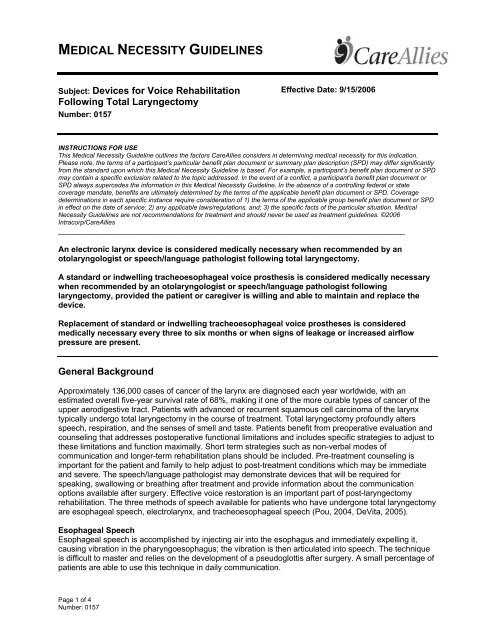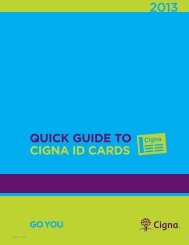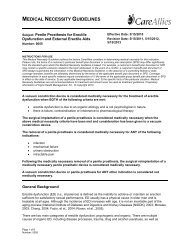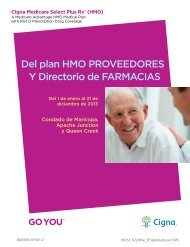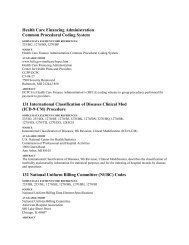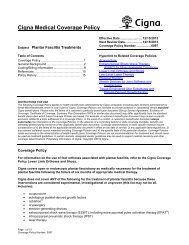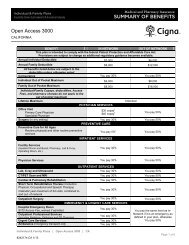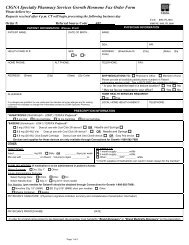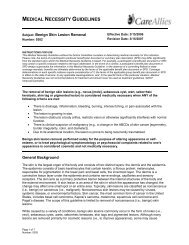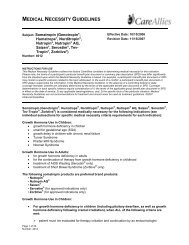MEDICAL NECESSITY GUIDELINES - Cigna
MEDICAL NECESSITY GUIDELINES - Cigna
MEDICAL NECESSITY GUIDELINES - Cigna
Create successful ePaper yourself
Turn your PDF publications into a flip-book with our unique Google optimized e-Paper software.
<strong>MEDICAL</strong> <strong>NECESSITY</strong> <strong>GUIDELINES</strong><br />
Subject: Devices for Voice Rehabilitation<br />
Following Total Laryngectomy<br />
Number: 0157<br />
Page 1 of 4<br />
Number: 0157<br />
Effective Date: 9/15/2006<br />
INSTRUCTIONS FOR USE<br />
This Medical Necessity Guideline outlines the factors CareAllies considers in determining medical necessity for this indication.<br />
Please note, the terms of a participant’s particular benefit plan document or summary plan description (SPD) may differ significantly<br />
from the standard upon which this Medical Necessity Guideline is based. For example, a participant’s benefit plan document or SPD<br />
may contain a specific exclusion related to the topic addressed. In the event of a conflict, a participant’s benefit plan document or<br />
SPD always supercedes the information in this Medical Necessity Guideline. In the absence of a controlling federal or state<br />
coverage mandate, benefits are ultimately determined by the terms of the applicable benefit plan document or SPD. Coverage<br />
determinations in each specific instance require consideration of 1) the terms of the applicable group benefit plan document or SPD<br />
in effect on the date of service; 2) any applicable laws/regulations, and; 3) the specific facts of the particular situation. Medical<br />
Necessity Guidelines are not recommendations for treatment and should never be used as treatment guidelines. ©2006<br />
Intracorp/CareAllies<br />
_____________________________________________________________________________<br />
An electronic larynx device is considered medically necessary when recommended by an<br />
otolaryngologist or speech/language pathologist following total laryngectomy.<br />
A standard or indwelling tracheoesophageal voice prosthesis is considered medically necessary<br />
when recommended by an otolaryngologist or speech/language pathologist following<br />
laryngectomy, provided the patient or caregiver is willing and able to maintain and replace the<br />
device.<br />
Replacement of standard or indwelling tracheoesophageal voice prostheses is considered<br />
medically necessary every three to six months or when signs of leakage or increased airflow<br />
pressure are present.<br />
General Background<br />
Approximately 136,000 cases of cancer of the larynx are diagnosed each year worldwide, with an<br />
estimated overall five-year survival rate of 68%, making it one of the more curable types of cancer of the<br />
upper aerodigestive tract. Patients with advanced or recurrent squamous cell carcinoma of the larynx<br />
typically undergo total laryngectomy in the course of treatment. Total laryngectomy profoundly alters<br />
speech, respiration, and the senses of smell and taste. Patients benefit from preoperative evaluation and<br />
counseling that addresses postoperative functional limitations and includes specific strategies to adjust to<br />
these limitations and function maximally. Short term strategies such as non-verbal modes of<br />
communication and longer-term rehabilitation plans should be included. Pre-treatment counseling is<br />
important for the patient and family to help adjust to post-treatment conditions which may be immediate<br />
and severe. The speech/language pathologist may demonstrate devices that will be required for<br />
speaking, swallowing or breathing after treatment and provide information about the communication<br />
options available after surgery. Effective voice restoration is an important part of post-laryngectomy<br />
rehabilitation. The three methods of speech available for patients who have undergone total laryngectomy<br />
are esophageal speech, electrolarynx, and tracheoesophageal speech (Pou, 2004, DeVita, 2005).<br />
Esophageal Speech<br />
Esophageal speech is accomplished by injecting air into the esophagus and immediately expelling it,<br />
causing vibration in the pharyngoesophagus; the vibration is then articulated into speech. The technique<br />
is difficult to master and relies on the development of a pseudoglottis after surgery. A small percentage of<br />
patients are able to use this technique in daily communication.
Electrolarynx<br />
An electrolarynx, or handheld artificial larynx, is frequently used to restore speech in post-laryngectomy<br />
patients. There are two types of electrolarynx devices: neck and intraoral. The neck type is placed against<br />
the skin on the side of the neck, under the chin, or on the cheek. Sound is conducted into the oropharynx<br />
and articulated. Intraoral devices are used for patients who cannot achieve sufficient sound conduction on<br />
the skin. A small tube is placed in the posterior oral cavity, and the generated sound is articulated. The<br />
electrolarynx allows immediate voice restoration after surgery, and is easy to learn. The device needs<br />
little maintenance, but does rely on batteries and produces a mechanical sound (Pou, 2004; Lombard,<br />
2003).<br />
Artificial larynx devices are Class I devices and are therefore exempt from U.S. Food and Drug<br />
Administration (FDA) pre-market approval (PMA) requirements. There are a number of devices available,<br />
including the UltraVoice (UltraVoice), the OptiVox (Bivona Medical Technologies), the Servox Inton ®<br />
(Siemens Hearing Instruments), and the TruTone and SolaTone (Griffin Laboratories).<br />
Tracheoesophageal Speech<br />
Tracheoesophageal speech is accomplished by a surgical voice restoration technique that evolved as a<br />
result of a procedure developed by Singer and Blom in 1979. A tracheoesophageal puncture creates a<br />
surgical fistula or tract in the wall separating the trachea and esophagus. A catheter is inserted in the tract<br />
as a stent. A speech pathologist measures the length of the puncture tract and selects an appropriate<br />
size and type of prosthesis. Several days after surgery, the catheter is removed, and a one-way-valved<br />
prosthesis is placed in the puncture tract. The one-way valve allows air to pass into the esophagus while<br />
preventing food and liquid from entering the trachea. The prosthesis allows air from the lungs to pass into<br />
the esophagus. Exhalation from the lung then vibrates the pharyngoesophageal segment to produce<br />
sound.<br />
To produce speech, the patient occludes the tracheostoma to direct air through the prosthesis into the<br />
esophagus. Hands-free external-airflow valves are also available that eliminate the need for finger<br />
occlusion. The tracheoesophageal voice prosthesis produces more natural-sounding speech and allows<br />
speech restoration within two weeks of surgery (Singer, 2004; Pou, 2004).<br />
Tracheoesophageal puncture for speech rehabilitation performed at the time of total laryngectomy is<br />
referred to as primary tracheoesophageal puncture. The procedure may also be performed weeks, or<br />
even years, following laryngectomy and is referred to as secondary tracheoesophageal puncture. The<br />
success rate for voice rehabilitation is generally higher when primary tracheoesophageal puncture is<br />
performed. One prospective case series evaluated the timing of placement of a Blom-Singer voice<br />
prosthesis for speech rehabilitation in 71 total laryngectomy patients. The rate of success for voice<br />
rehabilitation was 97% for patients who underwent primary tracheoesophageal puncture and 78% for<br />
patients who underwent secondary tracheoesophageal puncture. The use of radiotherapy and the age of<br />
the patient did not appear to impact the success rate (Chone, et al., 2005)<br />
There are several types of prostheses available. While some can be changed independently by the<br />
patient or caregiver, indwelling prostheses must be changed by a clinician. The patient, family, physician,<br />
and speech pathologist should select the prosthesis in concert. Phonation should be sampled with a<br />
patent puncture tract.<br />
Prosthesis options include the following:<br />
• Blom-Singer (duckbill): If voice quality is effortless, loud and consistent, a higher-resistance<br />
device such as a duckbill prosthesis is an option. This type of prosthesis is more durable than<br />
other types and can be changed by the patient.<br />
• Low resistance/pressure: If voice quality is strained, a lower-resistance prosthesis with a wider<br />
diameter may be appropriate. Low-resistance/pressure prostheses can also be changed<br />
independently but are less durable and more sensitive to esophageal pressure changes.<br />
• Indwelling: If the patient is unwilling or unable to change the prosthesis independently, an<br />
indwelling device may be appropriate. Indwelling prostheses are designed to remain in place for<br />
several months. The prosthesis can be cleaned daily by the patient or caregiver while in place,<br />
but must be changed by a speech and language pathologist or otolaryngologist (Lombard, 2003).<br />
Page 2 of 4<br />
Number: 0157
Postoperative voice rehabilitation is usually provided by a speech and language pathologist. The patient<br />
and family are instructed in removal, cleaning and reinsertion of standard prostheses and the patient is<br />
instructed in finger occlusion. Yeast colonization caused by constant exposure to esophageal contents in<br />
radiated patients eventually destroys the integrity of the valve. Aspiration may occur if fluids leak through<br />
a malfunctioning valve. A voice prosthesis should therefore be changed every three to six months and<br />
should be replaced sooner if signs of leakage or increased airflow pressure are present.<br />
Several devices have received FDA PMA approval and are available. These include the Hood<br />
VoiceMaster (E. Benson Hood), Provox 2 ® (Atos Medical), and several Blom-Singer devices (Helix<br />
Medical, Inc.).<br />
Summary<br />
Electronic larynx devices or tracheoesophageal voice prostheses (standard or indwelling) may be<br />
indicated for selected patients following total laryngectomy. Device selection is based on several factors,<br />
including the patient’s clinical condition, the patient’s and/or caregiver’s willingness and ability to maintain<br />
a device, and the recommendation of an otolaryngologist or speech and language pathologist.<br />
Coding/Billing Information<br />
Note: This list of codes may not be all-inclusive.<br />
When medically necessary:<br />
CPT ® * Description<br />
Codes<br />
31611 Construction of tracheoesophageal fistula and subsequent insertion of an<br />
alaryngeal speech prosthesis (e.g., voice button, Blom-Singer prosthesis)<br />
HCPCS<br />
Codes<br />
Description<br />
L8500 Artificial larynx, any type<br />
L8505 Artificial larynx replacement battery/accessory, any type<br />
L8507 Tracheo-esophageal voice prosthesis, patient-inserted, any type, each<br />
L8509 Tracheo-esophageal voice prosthesis, inserted by a licensed health care<br />
provider, any type<br />
L8511 Insert for indwelling tracheoesophageal prosthesis, with or without valve,<br />
replacement only, each<br />
L8512 Gelatin capsules or equivalent, for use with tracheoesophageal voice prosthesis,<br />
replacement only, per 10<br />
L8513 Cleaning device used with tracheoesophageal voice prosthesis, pipet, brush, or<br />
equal, replacement only, each<br />
L8514 Tracheoesophageal puncture dilator, replacement only, each<br />
ICD-9-CM<br />
Diagnosis<br />
Codes<br />
Page 3 of 4<br />
Number: 0157<br />
Description<br />
161.0 Malignant neoplasm of glottis; intrinsic larynx, laryngeal commissure [anterior]<br />
[posterior], true vocal cord, vocal cord NOS<br />
161.1 Malignant neoplasm of supraglottis; aryepiglottic fold or interarytenoid fold,<br />
laryngeal aspect, epiglottis [suprahyoid portion] NOS, extrinsic larynx, false vocal<br />
cords, posterior [laryngeal] surface of epiglottis, ventricular bands<br />
161.2 Malignant neoplasm of subglottis<br />
161.3 Malignant neoplasm of laryngeal cartilages. Cartilage: arytenoids, cricoid,<br />
cuneiform, thyroid<br />
161.8 Malignant neoplasm of other specified sites of larynx
161.9 Malignant neoplasm of larynx, unspecified site<br />
V10.21 Personal history of malignant neoplasm of larynx<br />
*Current Procedural Terminology (CPT ® ) © 2005 American Medical Association: Chicago, IL.<br />
References<br />
1. Chone CT, Gripp, FM, Spina, AL, Crespo AN. Primary versus secondary tracheoesophageal<br />
puncture for speech rehabilitation in total laryngectomy: long-term results with indwelling voice<br />
prosthesis. Otolaryngol Head Neck Surg. 2005 Jul;133(1):89-93.<br />
2. Crary MA, Carnaby GD. In: DeVita, VT, Hellman S, Rosenberg SA, editors. Rehabilitation after<br />
treatment for head and neck cancer. Cancer: Principles & Practice, 7 th ed. Lippincott Williams &<br />
Wilkins; 2005.<br />
3. Department of Health and Human Services (DHHS) Health Care Financing Administration<br />
(HCFA). Medicare Coverage Issues Manual. Section 60-23; speech generating devices.<br />
Accessed July 27, 2006. Available at URL address:<br />
http://www.cms.hhs.gov/transmittals/downloads/R132CIM.pdf<br />
4. Gluckman JL, Farrell ML, Kelly DH. Vocal rehabilitation following total laryngectomy. In:<br />
Otolarngology: head and neck surgery, 3 rd ed. New York: Mosby; 1998. P. 2285-2297.<br />
5. Kasperbauer JL, Thomas JE. Voice rehabilitation after near-total laryngectomy. Otolaryngol Clin<br />
North Am. 2004 Jun;37(3):655-77.<br />
6. Koch WM. Total laryngectomy with tracheoesophageal conduit. Otolaryngol Clin North Am. 2002<br />
Oct;35(5):1081-96.<br />
7. Lombard L. Laryngectomy rehabilitation. eMedicine. Updated 2006 Mar 18. Accessed July 27,<br />
2006. Available at URL address: http://www.emedicine.com/ent/topic312.htm<br />
8. Melfi RS, Garrison SJ. Communication disorders. eMedicine. 2004 Oct 13. Accessed July 28,<br />
2005. Available at URL address: http://www.emedicine.com/pmr/topic153.htm<br />
9. Mendenhall WM, Morris CG, Stringer SP, Amdur RJ, Hinerman RW, Villaret DG, Robbins KT.<br />
Voice rehabilitation after total laryngectomy and postoperative radiation therapy. J Clin Oncol.<br />
2002 May 15;20(10):2500-5.<br />
10. Pou AM. Tracheoesophageal voice restoration with total laryngectomy. Otolaryngol Clin North<br />
Am. 2004 Jun;37(3):531-45.<br />
11. Singer MI. The development of successful tracheoesophageal voice restoration. Otolaryngol Clin<br />
North Am. 2004 Jun;37(3):507-17.<br />
12. Stafford FW. Current indications and complications of tracheoesophageal puncture for voice<br />
restoration after laryngectomy. Curr Opin Otolaryngol Head Neck Surg. 2003 Apr;11(2):89-95.<br />
Page 4 of 4<br />
Number: 0157


